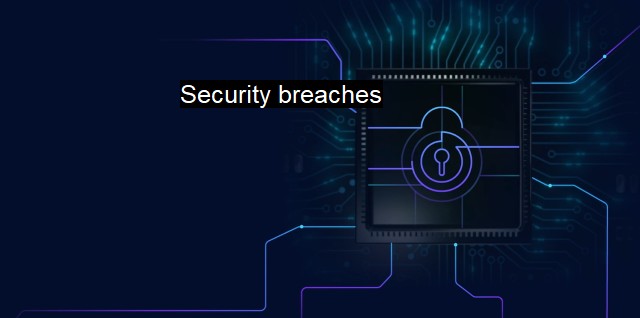What are Security breaches?
The Anatomy of Security Breaches: Understanding the Risks, Causes and Consequences for Companies and Individuals in the Digital Era, and How to Safeguard Yourself Using Antivirus Software
Security breaches, common refer to instances where unauthorized individuals obtain access to confidential, protected, or private data. These types of violations can substantially compromise a person's, company's, or institution's security by allowing access to critical information such as social security numbers, financial account information, personal email, personal health information, or any other personal identifiable information.In the sphere of cybersecurity, security breaches are often associated with attacks on the information systems of organizations, aiming to exploit weaknesses in the security infrastructure. This scenario causes numerous negative effects like the violation of the privacy of individuals or companies and a breach of trust towards the information handling entity.
In a world where technology and computer systems are rapidly developing and increasingly being relied on, security breaches are evolving concurrently. Cybersecurity breaches might occur when unauthorized individuals exploit cybersecurity vulnerabilities to gain illicit access to an information system. The intent behind this unauthorized access varies, from personal gain to competitive corporate advantage, disruption of services, or even cyberwarfare.
One prevalent form of security breach is malware attacks. Typically distributed through unsuspecting emails or infected websites, malware is created with a sole intention: gaining unauthorized access to a computer system. Common types of malware include viruses, worms, trojans, ransomware, spyware, adware and scareware, each distinctive in its operational mechanism once access is gained but equally dangerous.
Security breaches also originate from phishing schemes, a tactic where cyber attackers masquerade as reputable entities to steal sensitive data like login credentials, credit card numbers, or even tricking individuals into executing malicious software, thereby handing over direct access to their systems.
Another conventional form of data breaches is Denial-of-Service (DoS) attacks, where the perpetrators overwhelm the victim's network, server, or application with abundant traffic. These orchestrated attacks aren't designed to gain unauthorized access or steal data but rather a targeted disruption of services.
Certain advanced security breaches involved malicious individuals exploiting weaknesses in a targeted software or hardware to gain access to the system; these are known as zero-day exploits. In these scenarios, the vendor doesn't have any foreknowledge of the weakness or ways to swiftly fix the issue, providing the attacker unrestricted access until the vulnerability is patched.
Cybersecurity and antivirus software play instrumental roles in preventing security breaches. Antivirus software scans for, identifies and neutralizes threats on a device before they can exploit weaknesses in the system and lead to a security breach. Nonetheless, antivirus software can only protect against known bugs and attacks. Cybersecurity extends to unknown or zero-day threats; therefore, cybersecurity tools and protocols are incorporated, like sandboxing, behavior monitoring, firewalls, data encryption, vulnerability patching, or proactive threat hunting.
Organizations should invest in skilled personnel who specialize in cybersecurity. Sufficient human resources aid in the timeous discovery of impending threats and swift reactionary measures. educating all staff about the typology of security breaches and how to follow safety protocols helps to defend against attacks and mitigate the impact of breaches.
Security breaches can lead to devastating financial and reputation damage. Establishing robust cybersecurity infrastructures, effective monitoring and early detection systems, and instilling awareness about the fundamentals of cyber hygiene minimizes the detrimental aftermath of security breaches.
Continuing developments in the Cybersecurity landscape are crucial in creating, enhancing, and adaptive threat identification, prevention, and compensation systems, serving as the robust defense line against the exponentially advancing techniques and tools wielded by cyber attackers. recognizing the significance of cyber threat countermeasures directly contributes to the global fight against security breaches.

Security breaches FAQs
What is a security breach in the context of cybersecurity?
A security breach in the context of cybersecurity refers to an incident where an unauthorized party gains access to confidential or sensitive information of an organization or an individual without their consent. Such breaches can occur due to various reasons, including weak passwords, unpatched software vulnerabilities, phishing attacks, and malware.What are the consequences of a security breach?
The consequences of a security breach can be severe and long-lasting. It can result in financial loss, damage to reputation, loss of customer trust, and legal penalties. The affected organization or individual may also face downtime, disruption of services, and may require additional resources and time to recover from the breach.What are some preventive measures to avoid security breaches?
There are several preventive measures that an organization or individual can take to avoid security breaches. These include using strong passwords, regularly updating software and security patches, training employees on cybersecurity best practices, implementing multi-factor authentication, encrypting sensitive data, using antivirus software, and backing up data regularly.What should you do if you suspect a security breach?
If you suspect a security breach, you should immediately report it to the appropriate authorities and the affected organization's IT department. You should also change your passwords and monitor your accounts and financial statements for any suspicious activity. It is crucial to take quick action to minimize the damage and prevent further breaches.| | A | | | B | | | C | | | D | | | E | | | F | | | G | | | H | | | I | | | J | | | K | | | L | | | M | |
| | N | | | O | | | P | | | Q | | | R | | | S | | | T | | | U | | | V | | | W | | | X | | | Y | | | Z | |
| | 1 | | | 2 | | | 3 | | | 4 | | | 7 | | | 8 | | |||||||